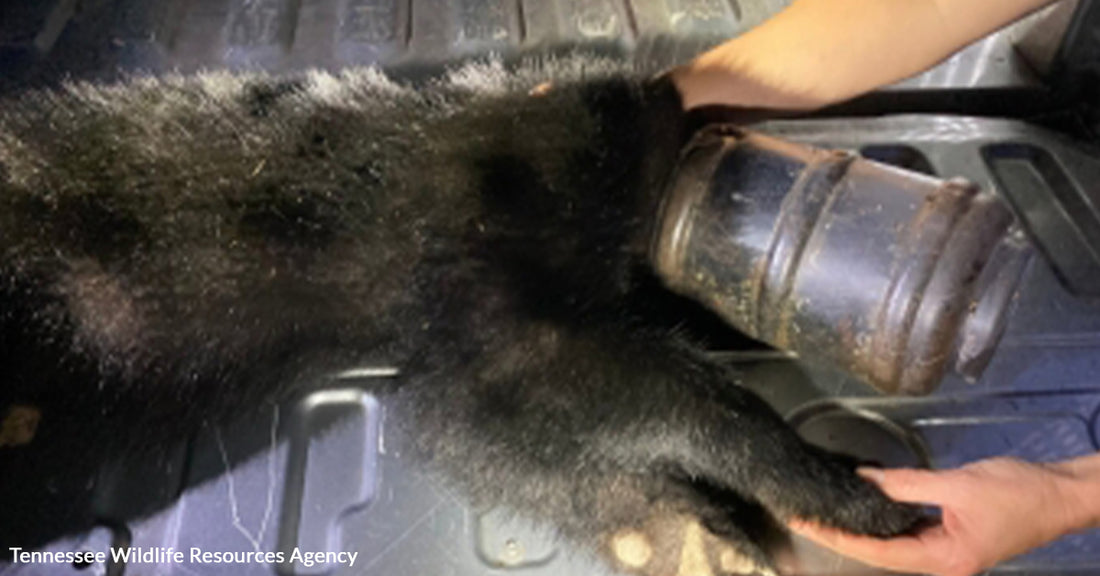Bear Cub With Pet Feeder Stuck On Head Evaded Traps For Weeks
Matthew Russell
Bears are majestic creatures that inhabit various parts of our world, and for many, encountering them in the wild can be a thrilling experience. However, it's essential to ensure that these encounters are safe for both humans and bears.
Recently, a heartwarming yet cautionary tale unfolded in Tennessee when a bear cub, later named Juggles, had a pet feeder stuck on its head for nearly two months.
This incident serves as a reminder of the importance of safe bear practices and the role we play in protecting these remarkable animals.
 Photo: Tennessee Wildlife Resources Agency
Photo: Tennessee Wildlife Resources AgencyThe Tennessee Wildlife Resources Agency is stressing the importance of bear safety after removing a plastic pet feeder from a bear cub’s head.
The Bear Cub's Ordeal
On August 14, a sow bear and her four cubs were spotted on a resident's porch near Chilhowee Lake in Tennessee, according to WBIR. One of the cubs had a plastic pet feeder stuck on its head.
Tennessee Wildlife Resources Agency (TWRA) Black Bear Support Biologist Janelle Musser responded to the report and initiated trapping efforts.
Musser faced significant challenges while trying to rescue the cub. According to WBIR, she attempted to lure it into a trap, but the container prevented the cub from triggering it with its mouth. Musser's determination led her to move the trap multiple times and even try different trap styles with foot plate triggers.
Unfortunately, the mother bear became wary of the traps, making the rescue efforts more challenging.
 Photo: Pixabay
Photo: PixabayTo discourage unwanted bear visits, never leave pet food outside; feed pets in single portions and remove bowls afterward.
“Once you’re in that area, it’s very difficult for our dispatch, which is how things are reported to our agency, to get you information once you’re down there,” Musser said. “So a lot of times it was it was just waiting for a report and also monitoring our traps.”
After nearly two months of struggle, the cub was finally located in a tree on October 3, the Charlotte Observer reported. In an emergency measure, Musser darted the cub and successfully removed the container from its head.
“Darting bears in trees is not standard practice and is only done in an emergency," Musser said. "This cub would not be able to continue surviving like this.”
Despite its ordeal, the cub, named Juggles, remarkably had no abrasions and was in relatively good shape. Musser's efforts, coupled with community support, played a pivotal role in this successful rescue.
 Photo: Pixabay
Photo: PixabayAvoid surprising bears if you see them in the wild.
Understanding the Attractants
Pet food, like the one found in the automatic pet food feeder, is a potent attractant for bears, reports the Tennessee Wildlife Resources Agency. Bears have an incredibly keen sense of smell and can detect the scent of food from a considerable distance. Once they locate a food source, they are inclined to take advantage of it.
As WAPE reports, it's crucial to be aware of the top three attractants for bears when walking through their habitat:
- Garbage: Ensure that garbage and recycling are stored in bear-resistant containers or buildings.
- Bird Seed: Remove bird feeders when bears are active.
- Pet Food: Never leave pet food outside, and if you must feed pets outdoors, do so in single portions and remove bowls afterward.
 Photo: Pixabay
Photo: PixabayBe cautious near berry patches and animal carcasses, as they attract bears.
Bear Safety Practices
To prevent incidents like Juggles' unfortunate ordeal and protect both bears and humans, follow these tips from BearWise:
- Secure Food and Garbage: Use bear-resistant containers or buildings to store food, garbage, and recycling.
- Remove Bird Feeders: Take down bird feeders when bears are active, and consider using bird baths instead.
- Pet Food: Avoid leaving pet food outside, and if necessary, feed pets outdoors in single portions and remove bowls afterward.
- Grills and Smokers: Clean and store grills and smokers to remove any enticing food odors.
- Educate Yourself: Before moving to areas with large bear populations, proactively educate yourself on BearWise practices.
 Photo: Pixabay
Photo: PixabayKeep a safe distance from bear cubs; mother bears are protective.
The Future for Juggles
Rescued bear cub Juggles is now recuperating at Appalachian Bear Rescue (ABR) in Townsend, WATE reports. Juggles received a medical check at the University of Tennessee College of Veterinary Medicine and is under the care of ABR staff.
Bears play a vital role in our ecosystems, and ensuring their safety is a shared responsibility. By following the right safety practices and taking proactive steps to prevent bear attractants, we can coexist peacefully with these magnificent creatures.
Help us protect both bears and ourselves, allowing these incredible animals to thrive in their natural habitats. Click below and pledge to care for bears!

